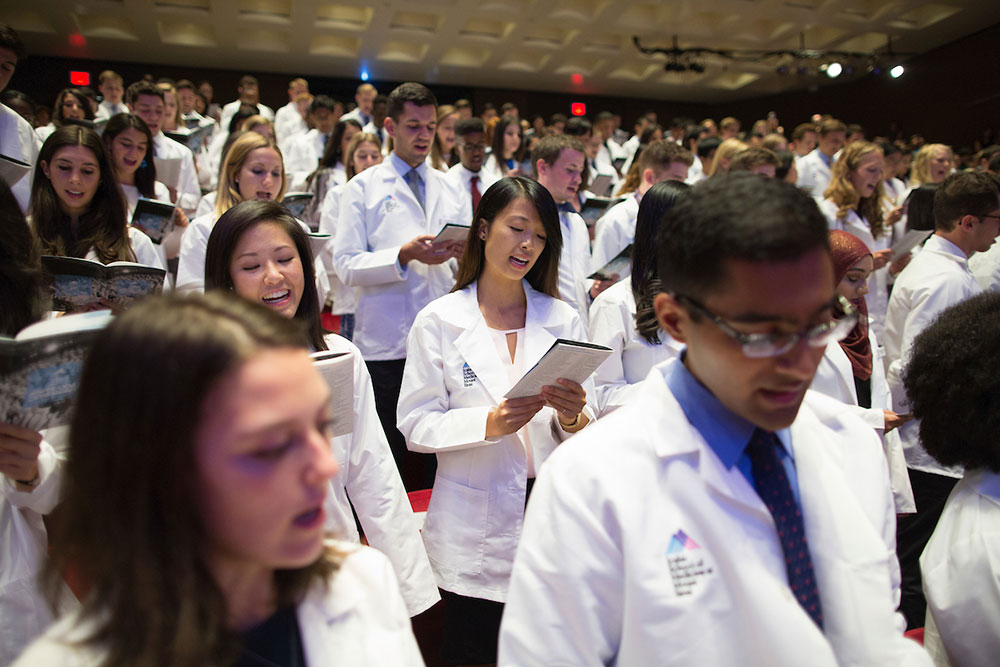 The following is the first in a two-part reflection piece written by Kamini Doobay, Class of 2015, during her Art and Science of Medicine (ASM) class.
The following is the first in a two-part reflection piece written by Kamini Doobay, Class of 2015, during her Art and Science of Medicine (ASM) class.
“Breathe with your patient – with your stethoscope placed correctly. In and out….and again, in and out.”
As I fumbled to get my earpiece in correctly and gently place the cold stethoscope on Mr. T’s back, Dr. Fierer spoke these words. Breathe with my patient? I nodded in acceptance, for he knew what he was doing and I clearly did not. My skepticism and self-doubt was not obvious. No one – the doctor, the patient or my fellow classmates – could tell that all I was thinking was,”How can I breathe with my patient and listen at the same time?”
This first week at my clinical site was a challenge to say the least. I left the clinic that afternoon knowing that I was breathing fine and that I could go through motions of a pulmonary exam. An onlooker could have very well thought that I knew what I was doing. I was discouraged and saddened, not so much because my ego was bruised, but because I wanted to know that I would be telling my patients the truth in the future. This is not a show or facade. I am accepting the invitation to enter the intimate chambers of my patients’ lives and in doing so, provide medical care based on open communication, mutual respect and unreserved empathy.
As I walked home that day, I took deep breaths—in and out, in and out—and paid attention. I listened to myself breathe, concentrating on just that and nothing else. Seeming to be the prototypical idle behavior, this simple activity was a powerful experience. This action required my full presence, my consciousness and moment-to-moment awareness.
As a drummer, I habitually tap my fingers on anything my hands land on—tables, walls, books, my thighs. In the library, I found myself playing ‘taals’ or beats to my own breathing – 1, 2, in and out.
I was eager to head back to the clinic and meet yet another individual who would grant me the privilege of touching them and listening to their heartbeats and breath sounds. Dr. Fierer’s own presence was calming and encouraging. His aura was one of humility, tranquility and comfort. I was ready to do the pulmonary exam. The middle-aged gentleman smiled and that alone invoked within me strong sentiments—courage, confidence, passion and will. I did the pulmonary exam and breathed with our patient, matching the tempo of his breath.
There we were, in a small, congested exam room, breathing together. I was able to listen fully to his breaths, immerse myself in that moment and follow him. I moved my stethoscope at the right pace just as I would move my fingers on the dholak while accompanying a classical Indian singer.
This felt blissful, almost as if I became one with this individual I had just met. With one sentence – one piece of instruction and guidance – Dr. Fierer had taught me so much. In time, I saw that each of his actions reinforced this basic principle. How can we alleviate suffering and cultivate compassion if we are not present in the moment, if we fail to truly become part of our patients’ stories, if we fail to listen to what they have to share with us?
View part 2 of Extraordinary Physician.
 Kamini Doobay is in ISMMS’s PORTAL program, as a MD/MSCR Candidate, Class of 2017.
Kamini Doobay is in ISMMS’s PORTAL program, as a MD/MSCR Candidate, Class of 2017.









